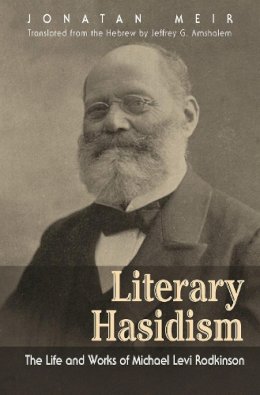
Stock image for illustration purposes only - book cover, edition or condition may vary.
Literary Hasidism: The Life and Works of Michael Levi Rodkinson (Judaic Traditions in Literature, Music, and Art)
Jonatan Meir
€ 41.90
FREE Delivery in Ireland
Description for Literary Hasidism: The Life and Works of Michael Levi Rodkinson (Judaic Traditions in Literature, Music, and Art)
Paperback. Michael Levi Rodkinson is today frequently referred to as a minor Hasidic author and publisher, a characterization based on the criticism of his opponents rather than on his writings. In Literary Hasidism, Meir draws on those writings and their reception to present a completely different picture of this colourful and influential writer. Series: Judaic Traditions in Literature, Music and Art. Num Pages: 248 pages. BIC Classification: 1KBB; 3JH; 3JJC; BGX; HRJS; KNTP. Category: (P) Professional & Vocational. Dimension: 229 x 152 x 19. Weight in Grams: 340.
Michael Levi Rodkinson (1845–1904) was a journalist, author, and publisher whose literary projects spanned numerous countries and continents. Hero to some and scoundrel to others, Rodkinson was a polemical figure whose beliefs underwent many transformations over the course of his life, most significantly from Hasidism to combative Haskalah to eventually anticipating the neo-Romantic trends of the early twentieth century. Throughout his career, Rodkinson’s writing challenged the familiar genres of the literature of Hasidism and the Haskalah, shaping the religious realities of his readers and articulating a spiritual and community life among Jews, who took his ideas to heart in surprising ways.
Today, Rodkinson is frequently referred to as a minor Hasidic author and publisher, a characterization based on the criticism of his opponents rather than on his writings. In Literary Hasidism, Meir draws upon those writings and their reception to present a completely different picture of this colorful and influential writer. Examining Rodkinson’s lifelong role as a catalyzing agent of different cultural phenomena, his diverse publishing activities, and his writings in their respective stages, Meir grants readers a provocative new vantage point from which to consider this divisive, enigmatic figure.
Today, Rodkinson is frequently referred to as a minor Hasidic author and publisher, a characterization based on the criticism of his opponents rather than on his writings. In Literary Hasidism, Meir draws upon those writings and their reception to present a completely different picture of this colorful and influential writer. Examining Rodkinson’s lifelong role as a catalyzing agent of different cultural phenomena, his diverse publishing activities, and his writings in their respective stages, Meir grants readers a provocative new vantage point from which to consider this divisive, enigmatic figure.
Product Details
Format
Paperback
Publication date
2016
Publisher
Syracuse University Press
Condition
New
Series
Judaic Traditions in Literature, Music and Art
Number of Pages
272
Place of Publication
New York, United States
ISBN
9780815634478
SKU
V9780815634478
Shipping Time
Usually ships in 15 to 20 working days
Ref
99-99
About Jonatan Meir
Jonatan Meir is associate professor at Ben-Gurion University of the Negev, Israel. He is the author of Imagined Hasidism: The Anti-Hasidic Writings of Joseph Perl and editor of Sefer Megale Temerin by Joseph Perl.
Reviews for Literary Hasidism: The Life and Works of Michael Levi Rodkinson (Judaic Traditions in Literature, Music, and Art)
Jonatan Meir portrays the career of one of the most ambivalent characters of the Haskalah, or Jewish Enlightenment, Michael Levi Rodkinson, and his move from the propagation of popular Hasidism to his more grandiose attempts to reframe and restructure the entire Jewish canon. This look into the world of the late nineteenthcentury Jewish Enlightenment will be an eye-opener.""—Pinchas Giller, Ziegler School of Rabbinic Studies, American Jewish University ""Meir has taken the relatively neglected figure of Rodkinson and created a detailed and fascinating portrait. He ably demonstrates that the boundaries between Hasidism and Haskalah were frequently crossed, and this markedly improves our understanding of the dynamics of Jewish intellectual history in the crucial period of the late nineteenth century.""—Ira Robinson, Concordia University
